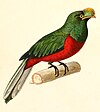Ceratogymna
| Ceratogymna | |
|---|---|
 | |
| Black-casqued hornbill (Ceratogymna atrata) | |
| Scientific classification | |
| Domain: | Eukaryota |
| Kingdom: | Animalia |
| Phylum: | Chordata |
| Class: | Aves |
| Order: | Bucerotiformes |
| Family: | Bucerotidae |
| Genus: | Ceratogymna Bonaparte, 1854 |
| Type species | |
| Buceros elatus[1] Temminck, 1831 | |
| Species | |
| 2, see text. | |
Ceratogymna is a genus of large, primarily frugivorous hornbills (family Bucerotidae) found in the humid forests of Central and West Africa. They are sexually dimorphic: males are all black, while females have brown heads and a smaller casque.[2] Unlike the members of the genus Bycanistes, the two species in the genus Ceratogymna have extensive, primarily blue, bare facial skin and dewlap, and the only white in their plumage is in the tail (although the yellow-casqued wattled hornbill has slight whitish speckling on the neck).
Species
| Common name | Scientific name and subspecies | Range | Size and ecology | IUCN status and estimated population |
|---|---|---|---|---|
| Black-casqued hornbill
| Ceratogymna atrata Temminck, 1835 | Angola, Cameroon, Central African Republic, Republic of the Congo, Democratic Republic of the Congo, Ivory Coast, Equatorial Guinea, Gabon, Ghana, Guinea, Liberia, Nigeria, Sierra Leone, South Sudan, Togo, and Uganda. | Size: Habitat: Diet: | LC
|
| Yellow-casqued hornbill
| Ceratogymna elata (Temminck, 1831) | West Africa | Size: Habitat: Diet: | VU
|

The members of the genus Bycanistes have been included in this genus, but today most authorities consider the two separate.[2]
References
- ^ "Bucerotidae". aviansystematics.org. The Trust for Avian Systematics. Retrieved 2023-07-26.
- ^ a b Kemp, A. C. (2001). Family Bucerotidae (Hornbills). Pp. 436-523 in: del Hoyo, J., Elliott, A., & Sargatal, J. eds. (2001). Handbook of the Birds of the World. Vol. 6. Mousebirds to Hornbills. Lynx Edicions, Barcelona. ISBN 84-87334-30-X
- v
- t
- e
- Kingdom: Animalia
- Phylum: Chordata
- Class: Aves
- Infraclass: Neognathae
- Clade: Coraciimorphae
- Clade: Cavitaves
|  | |||||||||||||||||||||
|  | |||||||||||||||||||
|   | |||||||||||||||||||||||||||||
| 
 | |||||||||||||||||||||||||||||||||||||||||
|  | |||||||||||||||||||||||
 | This Coraciiformes-related article is a stub. You can help Wikipedia by expanding it. |
- v
- t
- e












